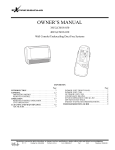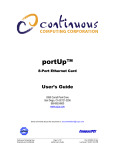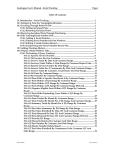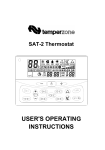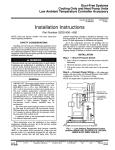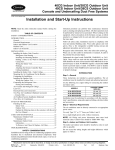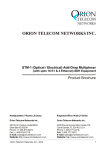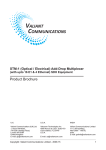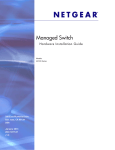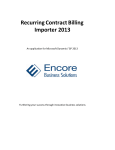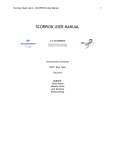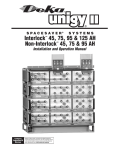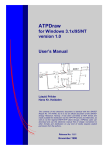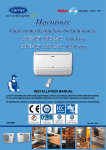Download Installation, Start-Up and Service Instructions
Transcript
38CG,CS018,024,030 40CG,CS018,024,030 Wall Console and Underceiling Duct Free Systems Installation, Start-Up and Service Instructions CONTENTS Page SAFETY CONSIDERATIONS . . . . . . . . . . . . . . . . . . . . . . 1 GENERAL . . . . . . . . . . . . . . . . . . . . . . . . . . . . . . . . . . . . . . 1-5 INSTALLATION . . . . . . . . . . . . . . . . . . . . . . . . . . . . . . . . 5-14 40CG,CS Indoor Unit Wall Installation . . . . . . . . . . . . 5 40CG,CS Indoor Unit Ceiling Installation . . . . . . . . . 7 38CG,CS Outdoor Unit Installation . . . . . . . . . . . . . . 10 Refrigerant Piping Connections . . . . . . . . . . . . . . . . . 13 Power Supply . . . . . . . . . . . . . . . . . . . . . . . . . . . . . . . . . . . 13 Air Vacuum and Refrigerant Charge . . . . . . . . . . . . . 13 Leak Test. . . . . . . . . . . . . . . . . . . . . . . . . . . . . . . . . . . . . . . . 14 Field-Installed Accessories . . . . . . . . . . . . . . . . . . . . . 14 START-UP . . . . . . . . . . . . . . . . . . . . . . . . . . . . . . . . . . . . . . . 14 System Checks . . . . . . . . . . . . . . . . . . . . . . . . . . . . . . . . . 14 CARE AND MAINTENANCE . . . . . . . . . . . . . . . . . . . . . 15 38CG,CS Outdoor Unit . . . . . . . . . . . . . . . . . . . . . . . . . . 15 40CG,CS Indoor Unit . . . . . . . . . . . . . . . . . . . . . . . . . . . . 15 Air Filters . . . . . . . . . . . . . . . . . . . . . . . . . . . . . . . . . . . . . . . 15 TROUBLESHOOTING. . . . . . . . . . . . . . . . . . . . . . . . . 15-17 SAFETY CONSIDERATIONS Installing, starting up, and servicing air-conditioning equipment can be hazardous due to system pressures, electrical components, and equipment location (roofs, elevated structures, etc.). Only trained, qualified installers and service mechanics should install, start-up, and service this equipment. Untrained personnel can perform basic maintenance functions such as cleaning coils. All other operations should be performed by trained service personnel. When working on the equipment, observe precautions in the literature and on tags, stickers, and labels attached to the equipment. Follow all safety codes. Wear safety glasses and work gloves. Keep quenching cloth and fire extinguisher nearby when brazing. Use care in handling, rigging, and setting bulky equipment. Before installing or servicing system, always turn off main power to system and install lockout tag on disconnect. There may be more than one disconnect switch. Electrical shock can cause personal injury. GENERAL These instructions cover the installation, start-up and servicing of 38CG,CS outdoor and 40CG,CS indoor units cooling only and heat pump duct free systems. Depending on the specific application, the 40CG,CS indoor units can be installed as either a wall console unit or under ceiling unit. See Fig. 1 and 2. See Tables 1 and 2 for parts included with systems. System Requirements • Consult local building codes and National Electrical Code (NEC, U.S.A.) for special installation requirements • Control wiring should be THHN 600V 18 gage • Use only type “G” or “C” fuses. • Use single length power cable without extension • Allow sufficient space for airflow clearance, wiring, refrigerant piping, and servicing unit. See Fig. 3A and 3B for minimum required distances between unit and walls or ceilings. • Indoor and outdoor units should be installed as close as possible to each other. • Condensate can form in the condenser in outdoor units during heating mode. A drainage hose can be installed to remove condensate. See Fig. 4. • Do not install indoor units near a direct source of heat such as direct sunlight, steam or flame. Manufacturer reserves the right to discontinue, or change at any time, specifications or designs without notice and without incurring obligations. PC 111 Catalog No. 533-80051 Printed in U.S.A. Form 38C/40C-2SI Pg 1 2-02 Replaces: 38C/40C-1SI Book 1 4 Tab 3e 2f 40CG, CS INDOOR UNIT Fig. 1 — Typical 40CG,CS Indoor Unit — Ceiling Application 40CG, CS INDOOR UNIT Fig. 2 — Typical 40CG,CS Indoor Unit — Wall Console Application 2 Table 1 — Parts List — Wall Console Units ITEM QTY Mounting Bracket(s) 1 Long Screws 9 Nut 2 Outdoor Sensor Connecting Cable 1 Absorption Cushions 4 Electric Terminals 16 Remote Controller Rack 1 DIAGRAM WIRELESS REMOTE CONTROLLER 11:45 S TA R T S TO P 1 2 3 D A I LY MODE SLEEP 72 FA N II I II Remote Controller and Batteries 1 Insulation for Fittings 1 Drain Hose Adapter 1 Owner’s Manual 1 I II II IIII II I I A 3 A SWEE P Table 2 — Parts List — Under Ceiling Units ITEM QTY Upper and Lower Mounting Strips 2 Right and Left Mounting Strips 2 Left Side Strip 1 Right Side Strip 1 Anchor Screw (3/8-in. x 2-in.) 6 Bracket Screw (UNC 10 x 2-in.) 8 Nut (UNC 10) 8 Metal Screw (#10–1/2-in.) 2 DIAGRAM C A A 6” (0.15m) MIN. 8” (0.2m) MIN. 8” (0.2m) MIN. B 6” (0.15m) MIN. 4” (0.1m) MIN. 2’ (0.6m) MIN. UNIT B 40CG,CS018 C 40CG,CS024,030 ION STALLAT FLOOR IN 2’ (0.6m) MIN. A 8.74-in. (225 mm) 8.74-in. (225 mm) B 24-in. (610 mm) 24-in. (610 mm) C 39.4-in. (1000 mm) 42.24-in. (1200 mm) Fig. 3B — 40CG,CS Indoor Unit Dimensions UNIT 38CS,GS 018,024 030 DIMENSIONS in. (mm) A B C 12.59 (320) 25.18 (640) 35.43 (900) 12.59 (320) 25.18 (640) 43.31 (1100) Fig. 3A — 38CG,CS Outdoor Unit Dimensions 4 40CG, CS UNIT 38CG, CS OUTDOOR UNIT REFRIGERANT LINES Fig. 5 — 40CG,CS Unit Refrigerant Line Routing Options ADAPTER d. Drill holes in wall as marked. Insert field-supplied wall plugs. e. Attach mounting bracket to wall with long screws provided. f. Check bracket is level and is secured tightly to wall. g. Hang unit on mounting bracket. See Fig. 8. h. Mark 2 holes from bottom of unit for later attachment of long screws. Hold down screws once installation of unit is complete. See Fig. 8. i. Remove unit from wall and drill holes. Install field-supplied wall plugs and replace unit on wall. NOTE: Hold down screws will be attached once unit is completely assembled. Fig. 4 — 38CG,CS Unit Drainage Adapter Connection INSTALLATION 40CG,CS Indoor Unit Wall Installation 1. Determine route of refrigerant piping lines to unit. See Fig. 5. Refer to Table 3 for refrigerant piping details. 2. Mount unit by performing the following steps: a. Carefully remove air intake grille and retaining spring by removing screws on both sides of grille. See Fig. 6. b. Remove and save 7 screws that attach front panel to unit. Remove front panel. Table 3 — Refrigerant Piping Detail 018 MAXIMUM LENGTH AND LIFT Length Lift ft (m) ft (m) 98 (30) 49 (15) 024 131 (40) 66 (20) 030 98 (30) 33 (10) UNIT 38/40CG,CS Be sure stepper motor and display cable are disconnected from electronic control before proceeding. c. Position mounting bracket level on wall and mark 7 holes as shown in Fig. 7. RETAINING SPRING LIQUID LINE (in.) VAPOR LINE (in.) 1/ 4 3/ 8 3/ 8 1/ 2 5/ 8 5/ 8 FRONT PANEL ATTACHMENT SCREWS AIR INTAKE GRILLE Fig. 6 — Removing Air Intake Grille and Front Panel — 40CG,CS Unit 5 e. Connect the ends of the refrigerant lines to their appropriate fittings, following the guidelines in the Refrigerant Piping Connections section. f. Make sure the drainage hose is at the bottom side of the wall hole. See Fig. 9. g. Connect the display panel connector to the display panel printed circuit board. See Fig. 10. h. Reassemble the front panel, using the 7 screws which appear in Fig. 6. 6. Attach the remote control rack. Use the two screws supplied to attach the remote controller rack to the wall in location selected by the customer. See Fig. 11. 3. Drill hole in wall to connect indoor and outdoor units: a. Drill a 3-in. hole from inside wall for the tubing that contains refrigerant lines, drainage hose and electric cables as shown in Fig. 9. Use unit as a template when determining hole location. NOTE: Be sure to drill outward and downward so the opening in the outside wall is at least 1/2-in. lower than the opening on the inside wall. b. Insert tubing through hole. Be sure the drainage hose is at the bottom side of the hole. See Fig. 9. c. Fill the remaining wall hole gap with an appropriate sealant material. 4. Make wiring connections. a. Route the electrical cable and the outdoor sensor cable toward the lower right corner of the indoor unit. b. Using a screw driver, insert the stripped wire ends into the terminal block as shown in Fig. 10. NOTE: Be sure the wires are connected in accordance with the wiring diagram located on the drain pan. c. Attach the electrical cable with the cable clamp located on the unit. d. Connect the Outdoor Sensor terminal TH3 connector to TH3 on terminal block. See Fig. 10. 5. Make drainage connections. a. Connect the unattached end of the drainage tube to the drainage hose outlet. b. Make sure there are no kinks, “U” bends or flattened sections in the tube. c. Seal the drainage connection to prevent leakage. d. Check that the drainage functions properly. Fill the pan below the unit’s coil with water and observe that it drains out freely. MOUNTING BRACKET NUT 2 8 Fig. 8 — 40CG,CS Indoor Unit on Mounting Bracket 3” (70mm) .5” (10mm) MIN. INDOOR OUTDOOR ELECTRICAL CABLE 9 10 STEP MOTOR TH3 TH2 TH1 HEAT TH3 TH2 TH1 Heat 8 POWER INDOOR OUTDOOR FAN CONTROL Power 2 8 Display 7 1 3 4 TH3 TH2 TH1 HEAT STEP MOTOR 5 DRAINAGE TUBE Fig. 9 — Suggested Tubing Diameter and Contents Fig. 7 — Mounting Holes on Wall 4 REFRIGERANT LINES OUTDOOR SENSOR CABLE WALL 3 9 LONG SCREWS LONG SCREWS Step Motor 8 Display 7 5 4 NUT MOUNTING BRACKET 1 3 TH3 TH2 TH1 Heat Power Step Motor 1 5 7 DISPLAY 10 DISPLAY 2 6 40CG, CS INDOOR UNIT 8 9 EXPLODED VIEW TERMINAL BLOCK Fig. 10 — Wiring Connections — 40CG,CS Indoor Units 6 40CG, CS UNIT 11:45 S TA R T S TO P 1 2 3 D A I LY MODE SLEEP 72 FAN SWEEP II I II I II II II I I A 1 2 3 4 ON REMOTE CONTROL IIII A SWITCHES Fig. 12 — Switch 1 Factory Default ON Position (40CG,CS Ceiling Installations Only) REMOTE CONTROL RACK 3. The location of the ceiling bracket should allow a minimum gap between the indoor unit and nearby walls, as shown in Fig. 13. 4. Drill hole in wall to connect indoor and outdoor units. a. Using unit as a template, drill a 3-in. hole from inside wall for the tubing that contains refrigerant lines, drainage hose and electric cables as shown in Fig. 9. 5. Mount unit by performing the following steps: a. Carefully remove air intake grille and retaining spring by removing screws on both sides of grille. See Fig. 6. b. Remove 7 screws that attach front panel to unit. Remove front panel. Fasten the left and right side strips on bracket to the air conditioner using 6 sheet metal screws (field supplied) as shown in Fig. 14. Be sure of the following: 1.) The wide side of the strip is located at the bottom of the air conditioner. 2.) The strip angle faces inward. c. Mount the indoor unit on the bracket. Slide the protruding parts of the side strips onto the ceiling bracket so that the 4 safety screw holes on the left and right strips align with those on the ceiling bracket. d. Make sure that the air conditioner is tilted slightly toward the drainage outlet on the right side. Use water to test for proper drainage. Correct the tilt by adjusting the height of the right strip relative to the left strip. e. Fasten the air conditioner to the ceiling bracket using the 4 side screws. (See Fig. 17.) WIRELESS REMOTE CONTROLLER Fig. 11 — Remote Control and Rack 40CG,CS Indoor Unit Ceiling Installation IMPORTANT: When performing a ceiling installation, make sure that Switch 1 on the Display Board is set to the ON position. See Fig. 12. The remaining switches are factory set and should not be changed. NOTE: The tubing connecting the indoor and outdoor units can be routed in one of two directions, as shown in Fig. 13. If the tubing is routed horizontally (direction no. 1), the pipe cover at the bottom of the air conditioner must be removed. See Fig. 14. If the tubing is routed vertically (direction no. 2), a condensate pump must be installed for drainage. 1. To assemble the ceiling bracket, use 4 mounting strips and 8 UNC-10 screws and nuts provided. See Fig. 15. 2. Fasten the ceiling bracket to the ceiling using the 6 anchor screws as shown in Fig. 16. NOTE: The anchor screws provided are intended for use with concrete ceilings. Use fasteners which are appropriate for the type of ceiling present at the installation site. 2 VERTICAL ROUTING HORIZONTAL 1 ROUTING REFRIGERANT LINES OUTDOOR SENSOR CABLE 40CG, CS INDOOR UNIT 4” (10 cm) MINIMUM ELECTRICAL CABLE DRAINAGE TUBE Fig. 13 — Routing Options for Cables, Refrigerant Lines, and Drainage Tube 7 d. Check that the drainage functions properly. Fill the pan below the unit’s coil with water and observe that it drains out freely. e. Connect the ends of the refrigerant lines to their appropriate fittings, following the guidelines in the Refrigerant Piping Connections section. f. Make sure the drainage hose is at the bottom side of the wall hole. See Fig. 9. g. Connect the display panel connector to the display panel printed circuit board. See Fig. 10. h. Reassemble the front panel, using the 7 screws which appear in Fig. 6. NOTE: If the drainage is routed in direction no. 1, as shown in Fig. 13, cut out an oval opening in the air intake opening for the drainage tube and route the tube through the air intake grille. See Fig. 18. NOTE: Be sure to drill outward and downward so the opening in the outside wall is at least 1/2-in. lower than the opening on the inside wall. f. Insert tubing through hole. Be sure the drainage hose is at the bottom side of the hole. See Fig. 9. g. Fill the remaining wall hole gap with an appropriate sealant material. 6. Drainage connections: a. Connect the unattached end of the drainage tube to the drainage hose outlet. b. Make sure there are no kinks, “U” bends or flattened sections in the tube. c. Seal the drainage connection to prevent leakage. 40CG, CS UNIT PIPE COVER WIDE SIDE Fig. 14 — Fastening Left and Right Sides to Air Conditioner 2 1 NUT 2 2 1 BRACKET SCREWS CEILING BRACKET 2 2 1 1 BRACKET SCREWS 2 ANCHOR SCREWS 2 Fig. 15 — Assembling the Ceiling Bracket 8 1 CEILING BRACKET ANCHOR SCREWS ANCHOR SCREWS Fig. 16 — Mounting Ceiling Bracket to Ceiling PROTRUSION SIDE SCREW NOTE: BE SURE TO FASTEN THE 4 SAFETY SCREWS ON THE SIDES OF THE UNIT. CEILING BRACKET SIDE SCREW SIDE SCREWS ADJACENT ROOM AIR OUTLET PORTS 40CG, CS UNIT Fig. 17 — Mounting Indoor Unit Onto Ceiling Bracket AIR INTAKE GRILLE CUT-OUT DRAINAGE TUBE Fig. 18 — Drainage Tube Routing Option 9 38CG,CS Outdoor Unit Installation e. Connect the outdoor sensor cable TH3, making sure the connector is properly inserted. f. Secure the inter-unit electric and sensor cable to the outdoor unit with the clamp shown in Fig. 19. g. Reassemble the plastic side cover. NOTE: A drainage tube can be connected to the outdoor unit to remove condensation formed during heating mode operation. NOTE: The outdoor unit must be installed on a solid surface. 1. Fasten the outdoor unit legs to the base, as shown in Fig. 19. 2. Place the rubber absorption cushions (supplied with the outdoor unit) under the unit’s legs to prevent vibrations. 3. Be sure that the unit is level. 4. Make wiring connections. a. Remove the outdoor unit plastic side cover. b. Loosen the screws on the terminal block. c. Attach the electrical terminals supplied to the interunit control and power cable wires. d. Connect the wires to the terminal block as shown in Fig. 20A-20C. Make sure that all screws and wires are properly fastened. Loose wires or connections can cause damage and present a fire hazard. 1 23 456 7 1 23 456 7 PLUG TO CONNECT WITH OUTDOOR SENSOR CABLE (TH3) INTER-UNIT ELECTRIC CABLE CLAMP 38CG, CS OUTDOOR UNIT ABSORPTION CUSHION X4 Fig. 19 — Wiring Connections and Location of Legs on Base — 38CG,CS Outdoor Units INDOOR UNIT HIGH SPEED HEAT PUMP MEDIUM SPEED LOW SPEED COMPRESSOR HEATING ELEMENT 1 3 4 5 7 10 PHASE (R) NEUTRAL PHASE (S) PHASE (T) 2 6 8 9 OUTDOOR UNIT BLACK 1 BROWN 2 YELLOW 3 GRAY/ORANGE 4 RED 5 BLUE 6 WHITE 7 8 9 ORANGE 10 TIME DELAY FUSE OR CIRCUIT BREAKER OUTDOOR SENSOR CABLE (TH-3) Fig. 20A — Wiring Diagram 10 MAIN SWITCH CON7 CON8 6 4 2 LEGEND AWG — American Wire Gage COMPR — Compressor FC — Fan Capacitor ST — Safety Thermostat TC — Terminal Cutoff TH — Thermistor RVS — Reversing Valve Solenoid • 12 AWG Wire •• 14 AWG Wire SWEEP MOTOR CON1 CONTR CON2 RL6 RL RL RL3 • BLUE BLK GR/YEL BLUE BR HEATER(OPT) CON6-9 5A CON6-3 5A RED CON6-1 5A CON6-5 FUSE 6A FAN MOTOR WH BR OR GRAY/OR FC WH RED YEL BK GR/YEL BR BLUE 7 10 4 5 3 1 BLUE YEL N 2 6 3 6 •• YEL HEATER • RED 5 1 2 • RED TC •OR •YEL ST • RED 3 4 6 CONTACTOR •• GR/YEL ••BR ••BLUE •• WH •• OR • YEL • OR •• RED •• YEL •• BK • BLUE • GR/YEL 1 2 3 4 5 6 7 10 2 1 OR WH 2 RED 16 • BLUE 9 BK 12 •BR 15 BK (YEL) A2 WH 2 •• BR 15 ONLY ON ROTARY COMP COMPR. R C S • BLUE OVERLOAD 4 A1 CONTACTOR 1 TH3 BLUE 10 PS J5 FC •GR/YEL 5 MODELS: (Outdoor) 38CS-018-301 38CS-024-301 38CS-030-301 •BR HEATER’S THERMOSTAT J3 1 2 3 4 5 6 7 10 TH3 P3 POWER SUPPLY • BR BLK BLK Fig. 20B — Wiring Diagram — 40CS/38CS Cooling Only Units MODELS: (Indoor) 40CS-018-301 40CS-024-301 40CS-030-301 CON4 CON9 •12VDC IH IL IT CON5-7 5A CON5-5 OH CON6 5A CON5-4 OH RL OL 5A CON5-6 RVS RL 1A CON5-1 1A CON5-3 COMP RL1 CON5 RL2 CON3 BLUE TH3 • GR/YEL 5 • BLUE RVS 1 23 456 1 23 456 WHT FAN MOTOR WH MAIN DISPLAY TAC - 460 • BLUE OUTDOOR UNIT • BR 14 • BR BK 12 BK INDOOR UNIT • BK WH 3 BR 13 BR RED YEL/GR 11 BK TB CON7 CON1 CON8 B 4 CONTR 2 0 CON2 LEGEND AWG — American Wire Gage CH — Crankcase Heater COMPR — Compressor FC — Fan Capacitor ST — Safety Thermostat TC — Terminal Cutoff TH — Thermistor RVS — Reversing Valve Solenoid • 12 AWG Wire •• 14 AWG Wire SWEEP MOTOR MAIN DISPLAY TAC-4 60 RL6 RL7 RL5 RL3 RL4 CON4 CON9 5A 5A CON6-3 5A BLUE HEATER(OPT) BLUE RED CO N6 - 1 GR/YEL FAN MOTO R WH FUSE BA BLK CON5 - 7 CON5-5 5A CON5 - 4 5A CON5 - 6 5A CON5 - 3 1A CO N6 - 5 CO N6- 9 BR 1A CON5 - 1 BR OR FC Y BK BR BLUE GR/YEL WH RED YEL GRAY/DR 2 6 7 5 4 3 1 0 •• BK • GR/YEL • • BR •• BLUE •• WH •• RED •• Y E L • BLUE N • BR L P OW E R S U P P LY 0 • GR/YEL BLK BLK Fig. 20C — Wiring Diagram — 40CG/38CG Heat Pump Units MODELS: (Indoor) 40CG-018-301 40CG-024-301 40CG-030-301 - 12 VD C IM IL IT CON6 OM OL OM RVS RL8 C O M P. RL1 CON5 RL2 CON3 TH3 7 6 5 4 3 2 1 P3 J3 7 6 5 4 3 2 1 TH3 BK 12 • BLUE 9 WH 2 R E D 16 BK(YEL) • BR 15 BK T H2 C • BR 15 S • BLUE ONLY ON ROTARY COMP OVERLOAD BK P5 J5 FC • GR/YEL 5 U N I T 1 2 3 4 5 6 BK BK FAN MOTOR WHT RVS 1 2 3 4 5 8 RED 16 MODELS: (Outdoor) 38CG-018-301 38CG-024-301 38CG-030-301 COMPR. CH R A1 A2 BLUE 10 CONTRACTOR 4 1 TH3 WH 2 TH1 O U T D O O R WH 3 BR 13 UN I T • BR 14 •BR BK 12 BK I N D O O R •BK •GR/YEL5 WH BR RED YEL/GR 12 Refrigerant Piping Connections — To connect the NOTE: The valves on the outdoor unit must remain closed until all 4 connections have been made. refrigerant lines: Use only “L” type sealed, dehydrated copper refrigerant tubing. No other type of tubing may be used. Use of other types of tubing will void the manufacturer’s warranty. Do not open service valves or remove protective caps from tubing ends until all the connections are made. Bend tubing with special bending tools to avoid the formation of sharp bends. Take care to avoid kinks or flattening of the tubing. Keep the tubing free of dirt, sand, moisture, and other contaminants to avoid damaging the refrigerant system. Avoid sags in the suction line to prevent the formation of oil traps. Insulate each tube with 3/8-in. walled thermal pipe insulation. Inserting the tubing into the insulation before making the connections will save time and improve installation. The suction and liquid lines should never come in direct contact. FLARING AND CONNECTING REFRIGERANT LINES 1. Remove the protective cap from the flare fitting. 2. Remove the protective cap from the tubing and cut to the required length. Be sure that the cut is perpendicular and clean, without burrs. 3. Slip the flare nut on the tubing and flare the tube end using standard flaring tools. 4. Tighten the nut until resistance is met. Mark the nut and the fitting. Using a suitable wrench tighten an additional 1/ turn. Use the following specified torque, according to 4 connection size: Liquid line: Suction line: 1/ -in. — (12.3 ft-lb) 1/ -in. — (36 ft-lb) 4 2 3/ -in. — (29 ft-lb) 5/ -in. — (47 ft-lb) 8 8 3/ -in. — (72 ft-lb) 4 Power Supply — See Tables 4 and 5 for electrical data and Fig. 19-20C for system wiring diagrams. Air Vacuum and Refrigerant Charge — When all the fittings are connected, air must be expelled. Follow the steps below to create an air vacuum. 1. Open the service port cap on the suction line valve (large valve). 2. Connect the vacuum pump to the service port via the pressure gauge and operate the pump for 15 minutes. 3. Be sure that full vacuum is present. Disconnect the vacuum pump. 4. Open the liquid line valve (small valve) with an Allen wrench. 5. Open the suction line valve (large valve) with an Allen wrench. 6. The outdoor unit is supplied with sufficient R-22 refrigerant for 26 ft of tubing. Add 0.9 oz of refrigerant and 0.35 oz of oil (field-supplied oil type 3GS or equivalent) for each additional foot of tubing used. If the tubing is shorter than 26 ft, remove gas from the system through the service valve into a recycling device. 7. Close the service port caps on the suction line and the liquid valves. 8. Make sure that the valves are properly opened. Be careful not to open them more than required as this may damage the thread. 9. Replace the stem cap. Oil the cap beam and hand tighten the cap, until resistance is met. Use a suitable wrench to tighten the cap by an additional 1/2 turn. Table 4 — Electrical Data, 40CG,CS Indoor Units — 208/230-1-60 UNIT 018 024 030 018 024 030 40CG 40CS MCA MOCP FULL LOAD AMPS FAN MOTOR AMPS 0.8 0.8 0.8 11.5 17.0 17.0 15 15 15 20 30 30 0.6 0.6 0.6 8.9 13.1 13.1 0.6 0.6 0.6 0.6 0.6 0.6 LEGEND MCA — Minimum Circuit Amps MOCP — Maximum Overcurrent Protection ELECTRIC HEATER (Watts) N/A N/A N/A 2000 3000 3000 ELECTRIC HEATER (Amps) N/A N/A N/A 8.3 12.5 12.5 NOTE: Specifications and performance data are subject to change without notice. Table 5 — Electrical Data, 38CG,CS Outdoor Units — 208/230-1-60 UNIT 38CG 38CS 018 024 030 018 024 030 MCA MOCP FAN MOTOR AMPS FULL LOAD AMPS 11.4 14.1 19.8 22.1 30.4 36.1 15 20 30 25 35 40 1.5 1.5 1.5 1.5 1.5 1.5 7.4 9.6 14.2 7.4 9.6 14.2 LEGEND MCA — Minimum Circuit Amps MOCP — Maximum Overcurrent Protection LOCKED ROTOR AMPS 48.0 61.0 94.0 48.0 61.0 94.0 NOTE: Specifications and performance data are subject to change without notice. 13 Leak Test — Leak test all fittings with appropriate test OUTDOOR UNIT 1. Are there unusual noises or vibrations during operation? 2. Is noise, drain water or airflow from the unit likely to disturb the neighbors? 3. Are there any gas leaks? equipment. Field-Installed Accessories TWO-WAY AIR CONDITIONER — CONSOLE APPLICATIONS ONLY (See Fig. 21) — Allows simultaneous air conditioning of adjacent rooms when installed as a console. 1. Prepare a wooden frame with the proper dimensions. See Fig. 21. 2. Locate the indoor unit and install mounting bracket. 3. Before mounting the indoor unit on the wall, open a hole in the wall to install the wooden frame using the unit as a guide. 4. Insert the frame in the wall and fill in any gaps between the frame and the wall hole with an appropriate fill material. 5. Cut the required number of openings in the insulation material on the back of the unit. 6. Mount the indoor unit on mounting bracket. 7. Seal any gaps between the back of the unit and the wall using a sealing material. 8. Install the grille into the wooden frame. Attach grille to the frame using 2 wood screws. 9. Refer to specific unit application to complete unit installation steps. TWO-WAY AIR CONDITIONER WITH AIR FEEDBACK — CONSOLE APPLICATIONS ONLY (See Fig. 22) — The air feedback grille is installed when air from the adjacent room is to be sampled by the thermostat when installed as a console. See Fig. 22. 1. Affix a field-supplied gasket around the air feedback opening at the rear of the air conditioner (approximately 12-in. from the opening). 2. Drill a hole in the shared wall to insert the return air tube. 3. Mount the indoor unit on mounting bracket. 4. Insert the tube into the hole until tube reaches the opening at the rear of the unit. 5. Insert the grille on the end of the tube. 6. Complete the installation by attaching the plastic frame to the wall using screws. 7. Refer to specific unit application to complete unit installation steps. EXPLAIN THE FOLLOWING ITEMS TO THE CUSTOMER, WITH THE AID OF THE USER MANUAL: 1. How to turn the air conditioner on and off; selecting cooling, heating and other operating modes; setting a desired temperature; setting the timer to automatically start and stop air conditioner operation; and the other features of the remote controller and display panel. 2. How to remove and clean the air filter. 3. How to set the air deflection louver. 4. Present the Owner’s Manual and this installation sheet to the customer. WALL THICKNESS REAR OUTLET GRILLE A WOODEN FRAME 6.8” (173mm) 4.4” (112mm) B .5” (12mm) 1.8” (45mm) NOTE: Dimensions are in inches (mm). OPEN SIZE A B (in.) (mm) (in.) (mm) ADJACENT ROOM AIR OUTLET PORTS* (Qty) 2 3 4 5 6 7 9.1 13.4 17.7 22.1 26.4 30.7 230 340 450 560 670 780 11.2 15.5 19.85 24.2 28.5 32.8 284 394 504 514 724 834 *See Fig. 17 for location of adjacent room air outlet ports. Fig. 21 — Dimensional Drawing — Two-Way Air Conditioner Frame REAR AIR OUTLET START-UP WOODEN FRAME System Checks WALL REAR OUTLET GRILLE 1. Hide the tubing where possible. 2. Make sure that the drainage tube slopes downward along its entire length. 3. Insulate tubing and connections. 4. Fasten tubes to the outside wall. 5. Seal the hole through which the cables and tubing pass. 6. Connect the air conditioner to the power source and turn it on. 7. Check all air conditioner operating modes. Refer to manual for operating details. EVAPORATOR ADJACENT ROOM AIR OUTLET PORTS INDOOR UNIT 1. Do all the remote controller buttons function properly? 2. Do the display panel lights work properly? 3. Does the air deflection louver function properly? 4. Does the drainage work? AIR FEEDBACK GRILLE PVC TUBE AIR FEEDBACK OPENING SPONGY GASKET Fig. 22 — Two-Way Air Conditioner 14 CARE AND MAINTENANCE LUBRICATION — The indoor-fan, automatic air sweep, and the outdoor-fan motors are factory lubricated and require no oiling. 38CG,CS Outdoor Units Air Filters Before performing recommended maintenance, be sure unit main power switch is turned off. Failure to do so may result in electric shock or injury from rotating fan blade. Operating your system with dirty air filters may damage the indoor unit and, in addition, can cause reduced performance, intermittent system operation, frost build up on the indoor coil, and blown fuses. Inspect and clean or replace the air filters monthly. CLEANING COILS — Coil should be washed out with water or blown out with compressed air. Clean coil annually or as required by location and outdoor air conditions. Inspect coil monthly and clean as required. Fins are not continuous through coil sections. Dirt and debris may pass through first section, become trapped between the row of fins and restrict outdoor unit airflow. Use a flashlight to determine if dirt or debris has collected between coil sections. Clean coil as follows: 1. Turn off unit power. 2. Using a garden hose or other suitable equipment, flush coil from the outside to remove dirt. Be sure to flush all dirt and debris from drain holes in base of unit. Fan motors are waterproof. TO REMOVE AIR FILTERS — Remove filters by pulling them straight out. TO CLEAN OR REPLACE FILTERS — Filters can be vacuumed or washed in warm water. Shake filter to remove any excess water, and replace by sliding filter behind grille until filter snaps in place. If the filter has begun to break down or is torn, replace it. Replacement filters are available through your Carrier distributor. TO CLEAN INDOOR UNIT BOTTOM/FRONT PANEL — If the bottom/front panel of the unit becomes dirty or smudged, wipe the outside of the panel with a soft dry cloth. Use a mild liquid detergent and wipe off carefully with a dry cloth. TO CLEAN INDOOR COIL — To clean the coil, remove indoor unit bottom/front panel and vacuum the coil fins, using care not to bend or damage fins. TO CLEAN CONDENSATE DRAINS — Clean all drains and drain pans at the start of each cooling season. Check the flow by pouring water into the drain. TO CLEAN OR REPLACE DRAIN PAN 1. Place a plastic sheet on the floor to catch any water that may spill from drain pan. 2. Remove the intake grille and distribution assembly. 3. Remove the condensate water in the drain pan by letting water drain into a 3-gallon bucket. 40CG,CS Indoor Units To avoid the possibility of electric shock, before performing any cleaning and maintenance operations, always turn off power to the system by pressing the mode button on the remote control until the display shows “OFF,” and turn off the separate disconnect switch located near the unit. If the indoor unit is on a separate switch, be sure to turn this disconnect off as well. Do not wash filter in water over 120° F (to avoid shrinkage). Do not expose filter to fire (to avoid fire damage). Do not expose filter to direct sunlight. Clean filter more frequently when air is extremely dirty. TROUBLESHOOTING Be sure to check for broken wires or loose cable lugs before troubleshooting system. Do not attempt to clean or service components in control box. 15 INDICATOR LAMPS TROUBLESHOOTING GUIDE LAMPS STATUS INDICATION Communication problem POWER flashes 10 seconds after A/C start-up (with or without other signal lamps). POWER, COMPRES. and PRESSURE lamps Thermistor failure flash. POWER, COMPRES. and IMPEDANCE lamps flash. Thermistor failure POWER lamp flashes and PRESSURE is lit, AIR CON is Off. Low Pressure POWER and PRESSURE lamps flash, AIR CON is Off. High Pressure FILTER is lit. POWER, IMPEDANCE lamps flash, COMPRES. is lit. Filter cleaning Low Voltage POWER lamp flashes, IMPEDANCE and COMPRES. lamps lit. AIR CON lamp flashes after A/C start-up. POWER lamp flashes, IMPEDANCE and COMPRES. are lit before A/C start-up. Voltage failure at start-up POWER lamp flashes IMPEDANCE and COMPRES. are lit. AIR CON is lit after A/C start-up. High voltage during compressor operation High Voltage 16 CORRECTIVE ACTION • Check connection between control (TAC-444) and display assembly (TAC-460) for control assembly (TAC-404). • Check thermostat (TH-1) for correct resistance. • Check for proper connection between TH-1 and TAC-444. • Replace TH-1 if necessary. • Check thermistor (TH-2) for correct resistance. • Check for proper connection between TH-2 and control (TAC-444). • Replace TH-2 if necessary. • Check if the filters are clean. • Check TH-1 and TH-2 for correct resistance. • Check cooling system for normal operation. • In Heat mode: Check if the evaporator is blocked. Also be sure filters are clean. • Check TH-2 (in Heating mode) or TH-3 (in Cool mode) for correct resistance. • Check cooling system for normal operation. • Clean all filters. • Check power supply voltage. • Check electrical connections. • Replace control (TAC-444). • Check power supply voltage. • Check electrical connections. • Replace control (TAC-444). • Check power supply voltage. • Check electrical connections. • Replace control (TAC-444). • Check power supply voltage. • Check electrical connections. • Replace control (TAC-444) GENERAL SYSTEM TROUBLESHOOTING GUIDE SYMPTOM A/C fails to start PROBABLE CAUSE a. Power supply to unit not connected (POWER LED Off). b. Fuse blown (POWER LED Off). c. ON/SEND has not been pressed. d. Indoor unit does not receive transmitted commands. e. AUTO-OFF-REMOTE switch is set to Off. Only indoor fan ventilator works when cooling or heating is desired a. The selected mode is Fan Only, or Cool when heating is desired. b. Temperature is set to a value which is too high (in Cool mode). a. In Heat mode: Indoor fan motor blocked. b. In Cool mode: System runs while evaporator anti-ice routine takes place. a. Run capacitor of outdoor fan motor is burnt. In Cool mode, high pressure or in Heat mode, outdoor coil freeze b. Winding of outdoor fan motor is shorted. a. Overload safety device on compressor is cut Only indoor fan motor and out due to high temperature. outdoor fan motor are working. No cooling and/or heating takes b. Compressor run capacitor is burnt. place c. Compressor winding shorted. a. Indoor fan motor is blocked or turns slowly. No air supply at indoor unit (compressor operates) Only indoor fan motor and compressor working. Outdoor fan motor stopped. Low capacity In Heat mode, only compressor runs. Outdoor and indoor fan motors are stopped. AIR CON indicator flashes. Water accumulates and overflows from evaporator drain pan Water dripping from the condenser base (in Heat mode) Unit does not operate in desired mode. The unit receives interference from other remote control or the remote control interferes with other instruments. In Cool mode, the unit (compressor) does not start. b. Indoor fan motor capacitor is burnt. c. Indoor fan motor winding is burnt. d. In Heat mode: Delayed start for indoor fan motor. e. Clogged air filters. a. Lack of refrigerant (will be accompanied by whistling noise): Causes ice formation on the evaporator coil (in Cool mode). b. Clogged air filters. A/C operates in de-icing cycle. Drain pan pipe or hose is clogged or the spout of drain pan is clogged. CORRECTIVE ACTION Check for proper connection of power at disconnect. Reset automatic circuit breaker or replace line fuse. Press ON/SEND button on remote control, or use the AUTO 3-position slide switch for automatic constant 72 F (22 C) set point (when remote control is not available). Make sure that nothing is blocking the remote control transmission to the unit display. Slide the 3-position switch on the Display to REMOTE (RMOT) position. Check if the remote control is in the desired mode. If not, select the correct mode (refer to User manual). Also note that every 15 minutes (max)., the compressor will be switched minimally on for 3 minutes. Observe the temperature setting on the remote control. Also note that each 15 minutes (max), the compressor will be switched on minimally for 3 minutes. Remove obstruction. Wait up to 90 seconds until anti-ice routine is completed. Replace outdoor fan motor run capacitor. Replace outdoor fan motor. Switch off power and try again after one hour. Replace compressor run capacitor. Replace compressor. 1. Check voltage. Repair wiring if necessary. 2. Check indoor fan wheel if tight on motor shaft. Tighten if necessary. Replace indoor fan motor capacitor. Replace indoor fan motor. Normal software delay (max. 20 sec). Clean filters. Unit must be charged (according to the nameplate) after localizing the gas leak. Clean filters. Wait 10 minutes (maximum) until the unit resumes normal operation. Disassemble plastic drain pipe from spout of evaporator drain pan. Flush with clean water. Water drain outlet or the spout is clogged. Open condenser cover, clean out water outlet, clean the base inside thoroughly. a. The 3-position slide switch on the unit display is Change the slider position to REMOTE (RMOT). in AUTO or OFF position. b. Faulty remote control settings. 1. If remote control symbols respond to the commands correctly, check the unit ID Code (Standard or Alternative). Refer to “Changing Unit ID Code” and to Remote Control DIP switch 3 setting in Control Assembly manual. 2. If Cool commands are OK, but Heat symbol is skipped on LCD, refer to Remote Control DIP switch 7 setting. 3. Replace remote control. c. Remote control low battery. Replace remote control batteries. d. IR detector. Try shorter distance between remote control and unit. If no response, replace IR detector. Common IR Code. Modify the Remote Control IR transmission code. Refer to “Changing Unit ID Code” and to Remote Control DIP switch 3 setting in control assembly manual. a. Faulty thermistor (outdoor) sensor. b. Faulty thermistor extension cable (between indoor and outdoor). 17 Replace the thermistor 3 (TH-3) sensor. Replace TH-3 extension cable. Copyright 2002 Carrier Corporation Manufacturer reserves the right to discontinue, or change at any time, specifications or designs without notice and without incurring obligations. PC 111 Catalog No. 533-80051 Printed in U.S.A. Form 38C/40C-2SI Pg 20 2-02 Replaces: 38C/40C-1SI Book 1 4 Tab 3e 2f




















